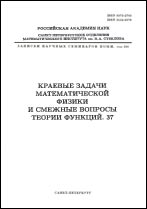|
|
Zapiski Nauchnykh Seminarov LOMI, 1977, Volume 68, Pages 115–122
(Mi znsl2004)
|
 |
|
 |
How to prove that two classes of simple primitive recursive functions are distinct
S. V. Pakhomov
Abstract:
Let $X$, $Y$ be classes of primitive recursive functions (for short PRF) and let it be required to prove the following statement: (I) It is not true that every function of class $X$ belongs to class $Y$. Such an assertion is usually proved by exhibiting a PRF of class $X$ which grows faster than any PRF of class $Y$, or by constructing some simple PRF's, e.g., $\lambda x(x+1)$, $\lambda xy(x+y)$, from class X, which do not belong to class $Y$. A method is proposed which gives a proof of an assertion of type (1) for some classes of PRF's $X$ and $Y$ such that first, functions of class $X$ do not increase faster than functions of class $Y$, and second, the class $Y$ contains simple PRF's such as $\lambda xy(x+y)$, $\lambda xy(x-y)$, etc. The proposed method is as follows. We choose some class of PRF's $Z$ and for each PRF $f$ we construct an operation $\delta_f$ on the functions of the class $Z$ such that for every $f$ in $Y$, the class $Z$ is closed with respect to the operation $\delta_f$, but on the other hand it is not true that for every f of $X$ the class $Z$ is closed with respect to $\delta_f$. We describe one of the possible applications of the method. We shall not distinguish between word and number PRF's and predicates, bearing in mind the following one-to-one correspondence between words in the alphabet $\{1,2\}$ and natural numbers: the word $a_na_{n-1}\dots a_1a_0$ in the alphabet $\{1,2\}$ corresponds to the number $\sum^n_{i=o}a_i2^1$. Let $\nu(x,i)$ equal the $i$-th letter in the word $x$ (the last letter – is taken to be the $0$-th sign), $|x|$ is the length of $x$; $\operatorname{con}(x,y)$ is the result of concatenating the word $y$ to the right of the word $x$; $\theta$, $\overline\theta$ are the characteristic functions of equality and inequality. Let $RF$ be a class of PRF's obtained from the PRF's $\theta$, $\overline\theta$, $\operatorname{con}$, $\lambda x0$, $\sigma$, $I^n_k$, by the operation of bounded minimalization and composition of functions. We note that the class of relations of the class $RF$ is equal to the class of rudimentary relations. Let $R_sF(f_1,\dots,f_l)$ be a class of PRF's obtained from the PRF's $f_1,\dots,f_l$ by the operation of composition and the operation of putting into correspondence with the function $g$ an $f$ such that $f(\overline x,y)=\mu t_{\leqslant y}[tPy\& g(\overline x,t)=0]$, where $tPy\leftrightharpoons t$ is the subword $y$. We note that the characteristic function of every $s$-rudimentary predicate belongs to $R_sF_\alpha(\theta,\overline\theta,\operatorname{con},\lambda x0,\sigma,I^n_k)$. We take as $Z$ the class of such $\alpha$ in $RF$ which have the values $0,1,2$ and if $\alpha(\overline z,i)=0$ then $\forall k[\alpha(\overline z,i+k)=0]$. The operation $\delta_f$ is such that $[\delta_f(\alpha_1,\dots,\alpha_n)](\overline x,\overline z,j)=\nu(f(\sum^{x_1}_{i=0}\alpha_1(\overline z,i),2^i),j)$. Assertions of type (1) can be proved by the proposed method if for $X$ we take $RF$, and as $Y$ we take $Y-R_sF_\alpha(\theta,\overline\theta,\operatorname{con},\lambda x0,\sigma,I^n_k,\lambda xy(x+y),\lambda xy(x-y),\lambda xf(|x|),\lambda x2^{g(|x|)})$, where $f$ and $g$ belong to the class $RF$.
Citation:
S. V. Pakhomov, “How to prove that two classes of simple primitive recursive functions are distinct”, Theoretical application of methods of mathematical logic. Part II, Zap. Nauchn. Sem. LOMI, 68, "Nauka", Leningrad. Otdel., Leningrad, 1977, 115–122; J. Soviet Math., 15:1 (1981), 63–67
Linking options:
https://www.mathnet.ru/eng/znsl2004 https://www.mathnet.ru/eng/znsl/v68/p115
|

|




 Contact us:
Contact us: Terms of Use
Terms of Use
 Registration to the website
Registration to the website Logotypes
Logotypes








 Citation in format
Citation in format 